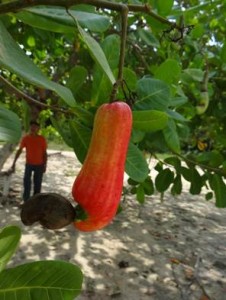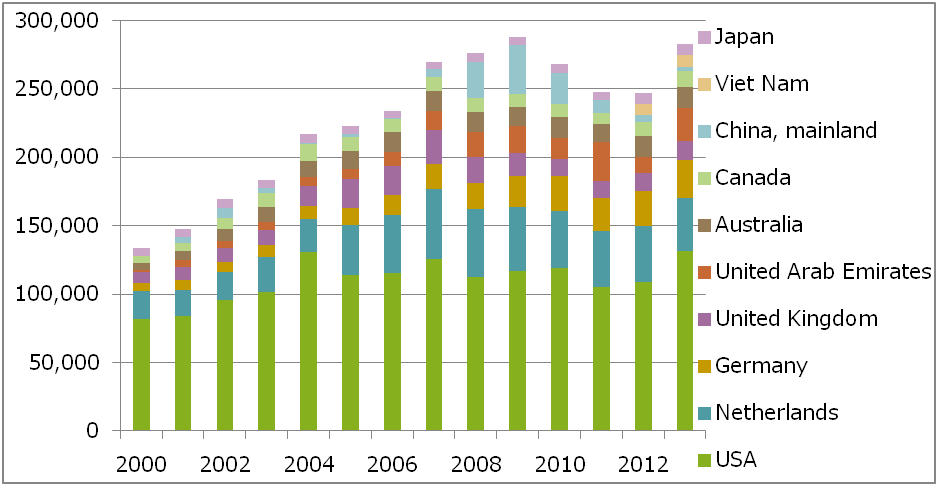Cashews

Source plants
- scientific name
- Anacardium occidentale L. (Anacardiaceae)
- general name
- Cashew nut trees
- overview
-
The cashew tree is tall and evergreen with early maturity, and is naturally distributed in South America. However, it is also widely distributed in tropical Asia, including the Philippines, Thailand, Vietnam, Sri Lanka, and India, and Africa. If certain conditions are met, it can grow to a diameter at breast height of 50 cm and a height of 20 m. It prefers areas with distinct dry and wet seasons, with temperature around 26–32 ˚C, humidity 75–85%, and annual precipitation 500–3,800 mm. While it can grow in oligotrophic soil and gravelly areas, clay and well-drained soil types, such as sandy loam and sandy soil, are ideal for cultivation. Also, it can grow in lowland forests with reduced soil fertility that are not suited to the cultivation of other fruit trees, as well as in secondary forests with gentle undulation, without cultivation, irrigation, or fertilizer application.
Product characteristics
- use
- In addition to the well-known use of cashew nuts as food, the oil contained in the shell of the cashew nut is used to make paints that have a lacquer-like finish and frictional materials for applications like automobile brakes. The cashew apple can either be consumed fresh or processed to make products like juice and jam.
- area
- Cashew trees are widely cultivated in the tropics, with the top 10 producing countries being Vietnam, Nigeria, India, Cote d’Ivoire, Benin, the Philippines, Guinea-Bissau, Tanzania, Indonesia, and Burkina Faso (FAOSTAT).
- overview
-
The fruit is a gray-colored kidney-shaped drape, with a size of approximately 2 cm and is covered with a shell (mesocarp). The comma-shaped nut (kernel), which is taken out from the fruit by breaking the shell, is consumed as a cashew nut. The shell is soft suberin and contains oil called cashew nut shell oil, which is used as oil as well as a raw material for waterproof paints. Some people may get a rash by having a contact with the oil. The enlarged peduncle (5–7 cm long) has a yellow to reddish bell pepper shape, a fresh apple-like aroma (thus called a cashew apple), and is processed into juice and jams.
A wide range of applications other than cashew nuts
Cashew nuts are extremely famous as food but have other applications, too. For example, the resin extracted from cashew nut shells is a lacquer-like synthetic resin developed in 1957 and patented by Cashew Co., Ltd. Cashew paint, compared to lacquer, allows easy painting, gives lacquer-like finish, and offers image clearness and durability. It is widely used in the lacquerware and craft industries (e.g., for household Buddhist altars and altar fittings, fusuma crafts, hina doll fittings, cabinetry, and the interior of buildings, such as shrines and temples) in Japan. The cashew resin paint is obtained by distilling and purifying cashew nut shell liquid (CNSL) contained in the cashew shell. CNSL is a phenol derivative and has anacardic acid (C22H32O3) as a main component. Anacardic acid turns into cardanol (C21H30O) through heating and decarboxylating after oil extraction. In addition to cardanol, CNSL contains cardol (C21H31O2), a phenol homologue. These substances closely resemble urushiol (C21H31O2), a main component of lacquer, thus creating lacquer-like texture.
In addition to its use as cashew paint, CNSL derived from cashew nut shells is widely used as an essential ingredient for friction materials (e.g., brake disk pads, brake lining, and clutch facing in the automobile, train, and other industries). It is also used to modify rubber and phenol resin (e.g., to add flexibility).
In some countries, cashew apples, which have a unique flavor, are processed into juices and jams, as they are said to contain vitamin C five times higher than oranges, with abundant calcium and iron.Export and import trends, demands in Japan
A large proportion of cashews produced in the world are exported to India without processing (with shells). In India, imported cashews are separated into nuts (kernels) and shells, and CNSL is extracted from the shells. A large proportion of cashew nuts and CNSL imported by Japan is produced in several different countries and comes through India. Since 2012, Vietnam has been importing in-shell cashews and exporting shelled cashews.
Demands for cashew nuts are growing, especially in the U.S., and are expected to grow in other developed countries. Cashew production, in response to demand, is increasing mainly in the top three cashew-producing countries: Vietnam, Nigeria, and Cote d’Ivoire.
Fig. 1 Changes in the import of cashew nuts (shelled) by the top 10 importers (t) (Source: FAO)

Fig. 2 Changes in the output of cashew nuts (shelled) by the top 10 producers (t) (Source: FAO)
The amount of shelled cashews imported by Japan was 5,660 t in 2000 (10th in the world) and increased to 8,146 t in 2013. Japan imports over 80% of its shelled cashews from India; however, as mentioned, not all the cashews are produced in India because India is also the main importer of in-shell cashews, exporting shelled cashews by removing the shells.
Potential for forest-based business
Being growable in dry sandy areas, cashews are also cultivated in West Africa (currently, 30–40% of in-shell cashews produced in the world are from West Africa) and are a valuable cash crop in poor regions with low soil fertility. However, only 10% of the cashews produced in West Africa are processed, with the rest being exported cheaply to India unprocessed (as in-shell cashews). It is known that the prices of in-shell cashews sold by producers are only 15% of the retail prices of shelled cashews. If cashew-producing nations were able to export shelled cashews directly to major markets such as the U.S., bypassing India, the cashew-related industries in those producing nations would develop and those countries would greatly benefit economically. As an example, in a remote area in Tanzania where public services are deficient, a multinational agricultural firm constructed a cashew processing plant, where cashews are shelled manually and aging cashew trees are replaced. Initially, 350 people were employed producing 4 t/day; the business continued to grow, as of 2009, 4,500 people were employed, producing 72 t/day. Mozambique has a similar experience; it created employment by prohibiting the export of unprocessed cashews.
Recent trends tell us that demands for cashew nuts will continue to grow, primarily in the U.S. Also, in areas with low soil fertility, planting of cashew trees is expected to improve the livelihood of local people, as well as contribute to forest preservation. However, if India continues to monopolize cashew processing, it is possible that the economic returns that the cashew-producing nations should enjoy would not be appropriately created. Therefore, it is important that a system be created where the cashew-producing nations can also do the processing. For companies that have been importing cashews from India, changing the import source country may pose a high risk. However, considering that some African countries have many cashew trees that are 15–22 years old, about to enter the peak fruiting stage, it may be possible for cashew-importing countries to reduce raw material procurement costs by directly negotiating and trading with such countries, while transferring and disseminating processing technology to them. Additionally, as cashew trees have various applications, other than nut collection, forest businesses can be established around cashew trees by making sure maximum benefits are gained from them.
- references
-
- Dewees, P., Place, F., Scherr, S.J. & Buss, C. 2011. Investing in trees and landscape restoration in Africa: what, where, and how. Program on Forests (PROFOR). Washington, DC, USA.
- FAOSTAT
- 桜井尚武(1996)20.カシュー(森徳典ほか編著「熱帯樹種の造林特性」第1巻)132-136頁
- 東北化工株式会社のホームページ(http://www.tci-web.co.jp/common/download/outline_1611.pdf)
- カシュー株式会社、2005、油性漆塗料カシュー


